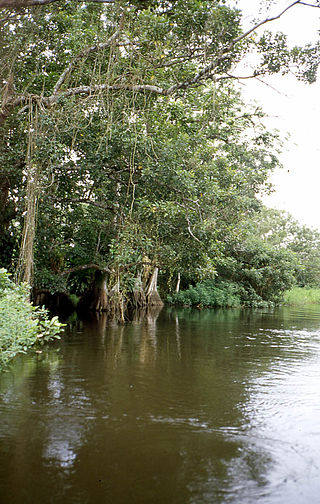National System of Conservation Areas is part of the Ministry of Environment and Energy (MINAE) of Costa Rica. It is the administrator for the nation's national parks, conservation areas, and other protected natural areas.

Protected areas of Brazil included various classes of area according to the National System of Nature Conservation Units (SNUC), a formal, unified system for federal, state and municipal parks created in 2000.
Las Camelias Lake Wildlife Refuge, is a wildlife refuge that is part of the Arenal Huetar Norte Conservation Area, in the northern part of Costa Rica, near Upala in the Alajuela Province, close to the border with Nicaragua. It protects palustrine wetlands and forests which serve as a feeding and breeding ground for 240 species of birds, including the Muscovy duck and jabiru. It was created in 1994 by decree 22753-MIRENEM.
Maquenque Wildlife Refuge, is a protected area in Costa Rica, managed under the Arenal Huetar Norte Conservation Area, it was created in 2005 by decree 32405-MINAE.
Ostional Mixed Wildlife Refuge, is an 85.7 km2 (33.1 sq mi) Wildlife refuge of Costa Rica, part of the Tempisque Conservation Area, was originally declared a protected area in 1982, and its status has been changed several times since then, including covering a larger area both on land and out to sea. It was created to protect important nesting beaches of the Olive ridley sea turtle.
Laquipampa Wildlife Refuge is a protected area in the region of Lambayeque, Peru. It protects tropical dry forests, habitat of the white-winged guan and the spectacled bear.

Pantanos de Villa Wildlife Refuge is a protected area of marshes located in the district of Chorrillos, within the city of Lima, Peru with an extension of 263.27 hectares (2.63 km2).

Los Guatuzos Wildlife Refuge has an area of 437.5 km2 (168.9 sq mi) and is located south of Lake Nicaragua and west of the San Juan River in Nicaragua. Los Guatuzos is a protected area consisting of tropical wetlands, rainforest, and wildlife refuge, it is the only internationally registered tropical wetland area in Nicaragua.
The Castanheiras Pied Tamarin Wildlife Refuge, formerly Castanheiras Pied Tamarin Ecological Reserve, is a wildlife refuge in the municipality of Manaus, Amazonas, Brazil. It was created in 1982 to protect a colony of pied tamarins.

The Laguna Cartagena National Wildlife Refuge is a 1043-acre National Wildlife Refuge in Lajas, Puerto Rico. It is part of the Caribbean Islands National Wildlife Refuge Complex.

The Vieques National Wildlife Refuge is a National Wildlife Refuge on the island of Vieques in the Puerto Rico archipelago. It is part of the Caribbean Islands National Wildlife Refuge Complex.
Protected areas of Panama include:
Corredor is a surname. Notable people with the surname include:
The Ilhas do Abrigo e Guararitama Wildlife Refuge (Portuguese: Refúgio de Vida Silvestre das Ilhas do Abrigo e Guararitama is a wildlife refuge off the south coast of the state of São Paulo Brazil.
The Una Wildlife Refuge is a wildlife refuge in the state of Bahia, Brazil.

The Rio dos Frades Wildlife Refuge is a wildlife refuge in the state of Bahia, Brazil. It protects the land around the mouth of the Frades River. There is pressure, or opportunity, to develop the reserve for tourism.
The Boa Nova Wildlife Refuge is a wildlife reserve in the state of Bahia, Brazil.
The Santa Cruz Wildlife Refuge is a wildlife refuge in the state of Espírito Santo, Brazil.
Jairo Mora Sandoval Gandoca-Manzanillo Mixed Wildlife Refuge, is a protected area in Costa Rica, managed under the Caribbean La Amistad Conservation Area, it was created in 1986 by decree. It protects both a land portion as well as a marine portion. In 2013 the refuge was renamed to honour the murdered environmentalist Jairo Mora Sandoval. In 2014 land along the coast containing a number of small towns was removed from the refuge, due to complaints from the local residents about evictions and destruction of property due to strict building codes. It is one of only two places in Costa Rica where manatees still occur. It is located in a coastal beach region, fronted by coral reefs and clothed in tropical forest, with 1950-3000mm yearly precipitation.
Playa Hermosa-Punta Mala Wildlife Refuge, is a protected area in Costa Rica, managed under the Central Pacific Conservation Area, it was created in 1998 by decree 27210-MINAE.






